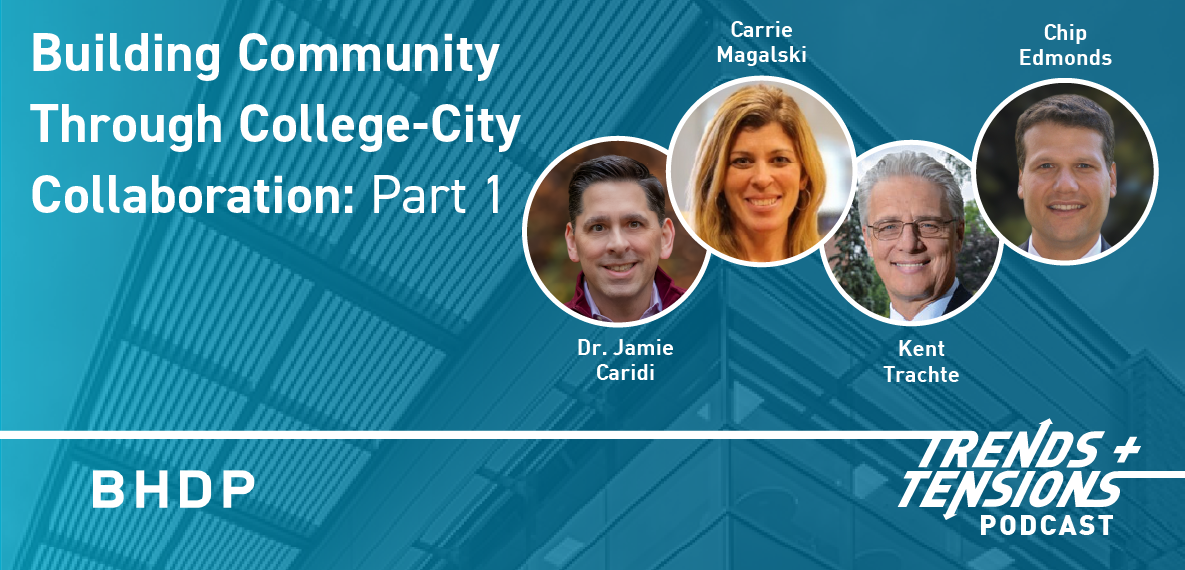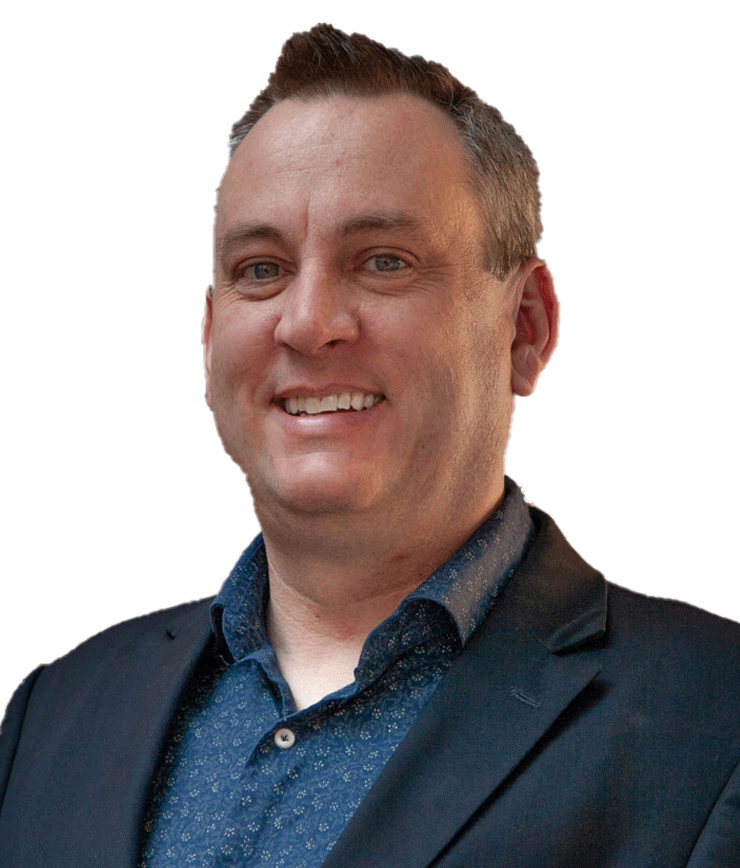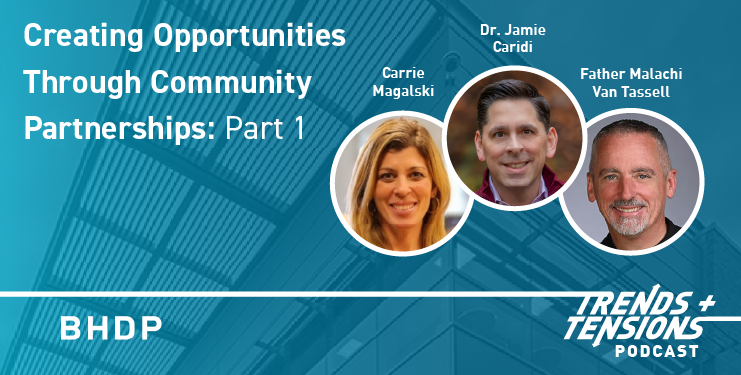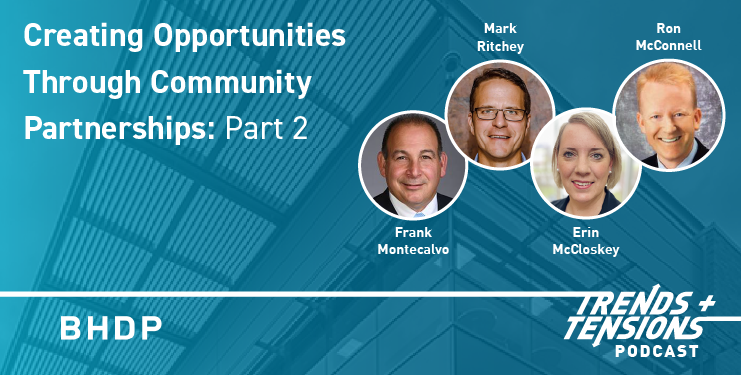
Building Community Through College-City Collaboration: Part 1

Want to listen on another platform? Choose your platform here.
Episode Transcript
[Music Intro]
Brian Trainer, Host:
Dr. Jamie Caridi: Hello, Dr. Trachte. It's a pleasure.
Carrie Magalski: How did you conceive this vision, and where are you in this process? And then really, as we go on today, is kind of securing what is the messaging that you would like to have as we tell and portray this project for you.
Kent Trachte: Wow, I don't know if I could remember all three of those at once. Now let's start off with the vision. So, I would say there were multiple factors that influenced the vision, and I'll talk a little bit about each one of those. The first factor is that I had the great opportunity to work at Franklin and Marshall College when John Frye was president at Franklin and Marshall, and Franklin and Marshall faced the challenge of finding ways to collaborate to revitalize the sector of Lancaster in which that college is located. And when I go into one of the other influences on me, there were some real parallels there. John had worked previously at Penn as an Executive Vice President when Penn had done a massive project in terms of partnering to renovate the neighborhood around Penn, and so I learned a lot from John about how to do this work, how to think about it, how to develop a vision. My own background had been much more of a traditional academic, starting as a faculty member progressing into administration, and so, as of 2002, I was really very much a novice in terms of thinking about how a college can become an economic anchor in the revitalization of a city or a portion of a city. So, the first part in execution of this was seeing it happen in Lancaster with Franklin and Marshall and learning some important facets of both how to develop the vision, but also how to execute it successfully. The second piece was we did an analysis in 2014, so in my first full year in office, where we really looked in some depth at data from what's called the admitted student survey, and really what we were trying to understand was, what did prospective students perceive as important, number one, and how did they rate or evaluate us relative to other institutions that they looked at, number two. And one of the things that emerged as both important to prospective students and where we were evaluated as not competing well was what was called surroundings in the admitted student survey. And so we had very tangible evidence that in terms of our bread and butter, which is enrolling students in the institution, that the way the neighborhood the sector of the city around Lycoming had evolved, as in so many older industrial cities, had become very much of a negative for us, in terms of our ability to recruit students. So that was a second factor. A third part of the evolution of the vision that I remember quite clearly was that Derck & Edson, whom you guys or at least BHDP knows well from having done landscape architecture work with us. I took a walk around the campus sometime in my early years with Steve Sproles, who's the principal at Derck & Edson, and one of the questions we were asking ourselves is, where was the arrival point for people at Lycoming College? And first part of the answer was there isn't a clear arrival point, okay, and then the second one is, well, what would make sense as an arrival sequence? And it was during that walk around campus where Steve and I stood on a knoll overlooking what is now the Basin Street Boulevard and said yes, this should be the arrival sequence. It makes all the sense in the world in terms of the highway and the exit and so on and so forth. So those were three factors. Then a group from the city came to see me — two members of city council, a member of the administration, and at least one businessperson who had property holdings in this area which are now called Old City — basically to inquire whether I was going to be the kind of president who saw Lycoming as a potential engine and anchor for economic development in Williamsport or whether my vision was going to be one of a college on the hill. And I think it's fair to say that, perhaps unintentionally, during the two decades preceding my arrival, the college had drifted toward being a college on the hill, even in the way in where its fences are and so on. It was as if we were signaling the community, “We don't want to be part of you, we are a college on the hill.” Of course, that was a popular concept, you know, for quite a few years. My response to that was, obviously, that I saw it as being important for Lycoming to be part of the economic revitalization of the sector of Williamsport where we were located. The mayor then appointed a commission to develop a vision for the revitalization of the East End Old City, there were all kinds of words, “gateway”. In consultation with the board, the college agreed to put in some nominal amount of money, $20,000 or something like that, to fund this study along with the city and so on, and I was named to that commission. And so being named to that commission, and we hired an urban planner to help us develop things, being named to that commission both began the process of building the relationships with the private sector and the public sector and also gave us an opportunity to participate in shaping the vision for what Old City might become. There was a county commissioner on that commission, the mayor was on the commission, there was a county planner, a member of city council, four or five different property holders, from that to private property holders, from that portion of Williamsport and so it really was kind of the acorn, if you will, from which the relationships that we now have in place were built. So, Carrie, those are the sort of fragments that I can remember right now in terms of, you know, how the vision came together.
Carrie: Hmm, that's fascinating. It’s fascinating how to see where it is now, just you know, for you to have taken an idea and then to watch it go into fruition. From what you've observed or you've perceived or with talking with families and students, how has this impacted the student experience? I was gonna ask about enrollment, but maybe even touching on the richness that this has brought to the student experience.
Kent: So, I want to break the student experience into two pieces. I want to break it into the prospective student experience and the enrolled student experience. And clearly, we didn't have a good first impression experience for that prospective student, right? Just in terms of, I mean, finding our admissions building previously was, I wouldn't even say negative. It was a horrible experience. They had to park in a parking lot on one part of campus and, with very poor signage, find their way to a dingy little admissions building, and then; on top of that, when they went on the campus tour, our facilities did nothing to sort of enhance or improve that vision. So, you know, part of what you guys should know is even as we've been doing this revitalization with external partners and the surrounding area, we've also been making significant investment in facilities on campus. Probably about 50 million altogether in my 10 years in office, both new buildings and revitalized buildings, and BHDP has been involved in both the new buildings and the revitalized and redesigned aspects of buildings, as well. But let me go back, and so the experience of the prospective student is totally different. It's a … it's one that is inspiring, engaging, exciting. And now we have, you know, new science facilities are renovated, old science building, renovated classrooms, now the brand-new music center, and instead of prospective students indicating kind of disappointment with the facilities, we see excitement. If your facilities are amazing, they're exciting, they're an asset for you. With our current students, as I indicated, the building has things for them in it. The center that arranges internships and career advising and all that is in there, the climbing wall is in there, the study rooms are in there. There are two classrooms that are in the building, and so those of our students are in the building. Now with the music center, they have a reason to migrate across Fourth Street to the music center. And then, as this development comes on, they're going to be retail and other reasons that will draw them further into Old City. And so, the student, current student experiences also being significantly enhanced because of new homes for critical programs and also, just the quality of the spaces that they're in.
Dr. Caridi: Can I ask a couple of rapid-fire questions? What would you do differently if you had to do it all over again? Maybe there's nothing, I don't know, but what didn't go as expected? Either it went more easily or more difficult. And then, you know, if you think about, think of our audience, right? We're speaking to other presidents, so what advice would you want to give to other presidents looking to do PPP projects?
Kent: I … I … nothing immediately comes to mind, Jamie, but I think it's important as part of that answer to say the entire road map was definitely not in my head. The vision was mostly there by the time we started, especially after we finished that commission work and we had done the south campus Master planning exercise with Derck & Edson and brought in BHDP, but I think probably the most important lesson I would say, is to anticipate that there are going to be unanticipated challenges and obstacles, and the importance of remaining nimble and bringing people together to forge creative solutions to those obstacles. Part of my answer is we, as a college Presidents, you have to recognize what you don't know, and most of us don't have experiences developers. John Frye was an exception. He had actually been doing kind of development work at Penn, but most of us don't. And so you got to find the right resources, somebody you trust to educate you, on, you know, how to think about, how to think like your prospective partners think so that you can come to a common ground or a common vision.
Dr. Caridi: That's exactly—
Kent: Does that answer your question, Jamie?
Dr. Caridi: Yeah, that's excellent.
Carrie: I just wanted to, you know, just take some time this morning just to hear your perspective, Chip, and really like, what is the messaging that you want to bring across?
Chip Edmonds: I guess for me, you know, it's what we have really been proud of is the significant work that we accomplished in getting people to have a shared sense of what's possible and what we needed to accomplish down in this area. And then that was first, you know. Then number two was starting to get and build the confidence that we could actually deliver on the things that we intended to do. That's, I think, at least as we think about what's really been great. But I … I think the larger piece that we hope comes out is that this really has been a very broad and deep kind of coalition of people that I do think is actually rare. And it has cut across organizations and entities. It's cut across government entities and private industry, and not-for-profits. It's cut across party lines and sort of ideological priorities or positions. And so, but all of it in, in service to a much stronger Downtown Williamsport that is contributing to a building or growing tax base.
Carrie: Taking on a project like this, or you know, starting from the vision to where it is now, how would you describe that process initially? Was this partnership more like an organic partnership? Was it something that took a lot of steps to, you know, kind of initiate? What was your perspective on that?
Chip: I think it started with a lot of listening early on, and this is where I'll give a lot of credit to Kent when he first arrived. And so I think early on it was hearing what other entities, what other pro—what private industry, and even with what the local government needed to try and accomplish down in this area, and what was next, and what some of the primary hurdles have been historically. And then taking all of that and determining what pieces of that were possible and if we pick those things up and prioritize them in a way that it also met our goals and objectives. So, it was really listening and then saying, okay, now let's apply what we've learned and heard to where we need to make a difference. So, we took a lot of data that we heard from the city, we put—there was an East End commission—we did a marketing study of that area and what was needed, and then we took our Nessie data, of what our students reported to us and told us, especially students who don't come here, and what were some of the shortcomings. And so, listening and finding those points of connection between the two, which, you know, led to, well, we don't have a great arrival sequence, and your first impressions are not awesome when you come to the campus. Once you get on, it's great and, you know, there aren't enough of the things that would be sort of considered trappings or the signals to families that, “Hey, this is a place or a city that's, that's holding its own and doing some good things.” And at the same time, the city's hearing, no one likes our housing stock it's old, people don't want to live here, and the not-for-profits are taking things off the tax rolls, and it's not building back that … the foundation that helps to move things forward. It's private industry saying, we're ready to do some things, but you know, we have a lot of other sort of absent landowners who are neglecting or blighted properties, and the city's not doing anything to address that. And it's PennDOT, who, you know, getting anything crew penned on is really challenging, but PennDOT also trying to strategize between city roads versus state roads versus local roads, and it's not so easy to get around. And so, you know, for a long time, every entity on their own was perfectly capable of naming the problems, but no one had the need or the overarching kind of view to actually solve these problems that struck in different ways with different entities. And I think that early on, that's the role that we really ended up playing.
Carrie: Mhm.
Chip: We saw what was possible, we listened to why it didn't happen before and who was responsible or why it was outside of PennDOT's purview, but perhaps out of the city's purview, and, you know, so, because of that no one's quite saying, “Hey, how do we collectively solve this?” And that's ultimately the role that we came in and played. Because we set all of these things to interface in a way that can help us institutionally, so what do we need to do to get it done?
Carrie: It sounds to me that, you know, what you've done with Lycoming and then the Old City Williamsport is kind of streamlined that process as a business model that universities can take across the board to replicate. What are some of your perspectives on how you would give advice to other universities? Like, how do you do an undertaking like this? What would be the initial, you know, starting point so it's not so overwhelming so that it could be a model to replicate?
Chip: Personally and professionally, when you get to be part of something and help advance something like this, it's exceptionally gratifying. So, I'll just, you know, I'll just say that how meaningful it has been to be part of it. And I think that's also what many others who've done this feel.
Carrie: Mhm.
Chip: Obviously, we all need to do things that help to drive the economic environment, which we are, but what impacts those things are desirability and people wanting to live in a certain place, the character people that you're doing the work with, these are all important factors that help to drive and make a project viable. And so, I would just say that, in addition to the coalition that's been created, in addition to the shared vision, it's happened with some really great people, that's as rewarding as anything.
Carrie: Well, we're very impressed, very impressed with the whole project. And want to extend our congratulations for all the work and everything you’ve put into it.
Dr. Caridi: It’s very helpful. Thank you very much.
Kent: I enjoyed it as well.
Chip: Nice meeting you.
Dr. Caridi: Take care.
Kent: Bye, thank you so much.
[Music]
Brian: Thank you for joining Trends + Tensions, presented by BHDP, for this special episode, “Building Community Through College: City Collaboration: Part 1”, with contributing hosts Dr. Jamie Caridi and Carrie Magalski. And their guests, Kent Trachte, and Chip Edmonds. If you appreciate what you've heard, please, rate, subscribe and give us a review. I am Brian Trainer, your host, and I hope you'll join us for part 2 when we continue this topic with leaders from the city of Williamsport, Pennsylvania.
[Music Outro]
Author
Content Type
Podcast
Date
June 05, 2023
Market
Practice
Topic
Higher Education Strategic Partnerships



